Printful vs Printify: Which Platform Is Better?
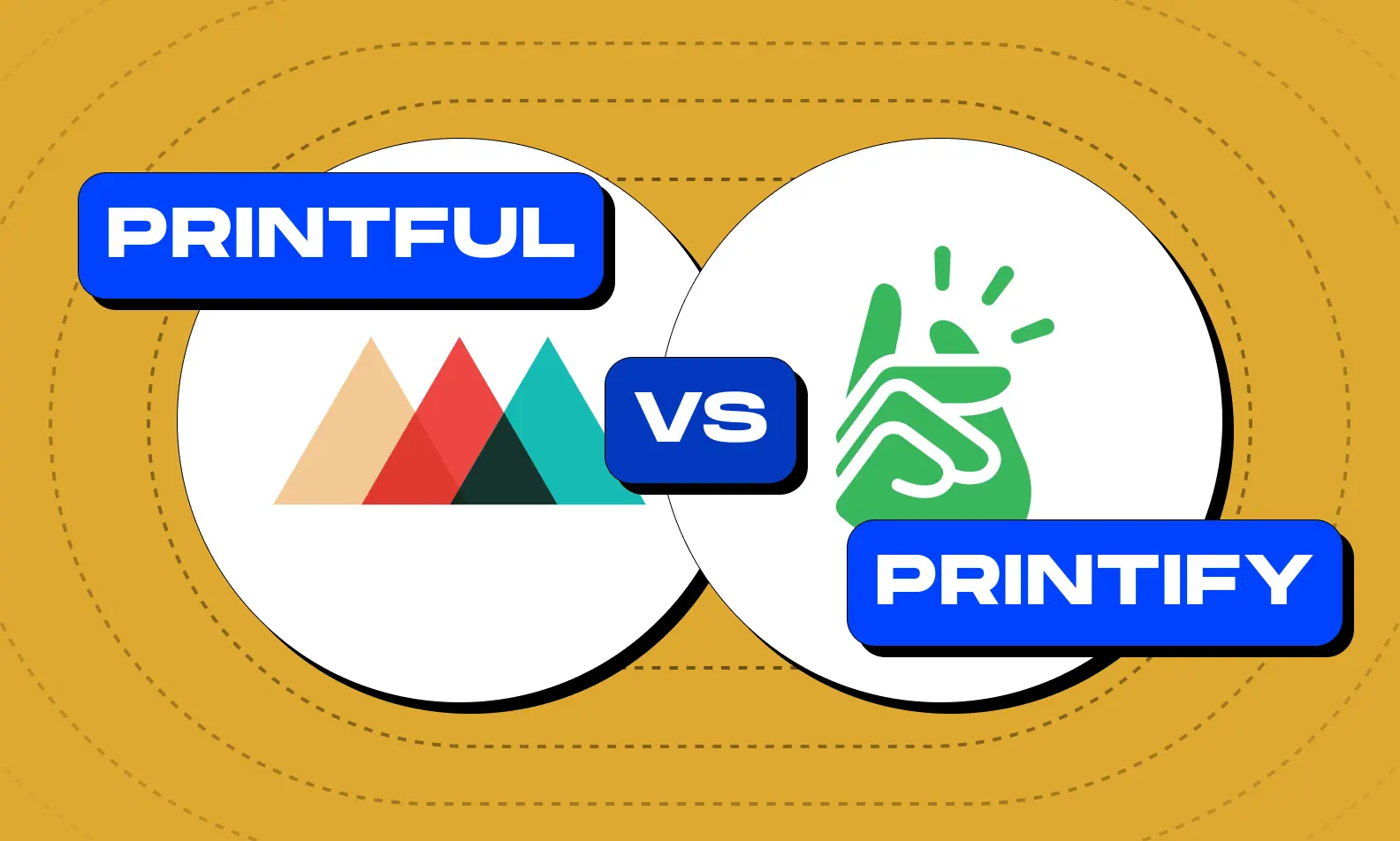
Printful vs Printify, which one reigns supreme?
When it comes to print on demand (POD), you definitely have heard of either of these platforms…or might have even gotten them mixed up.
For nearly a decade, these two POD companies have been at the forefront of the industry, offering entrepreneurs and creators a way to launch and scale their own custom merchandise businesses without the hassle of inventory management or upfront costs.
While both platforms provide similar services, they each have their unique strengths and weaknesses that can make a big difference depending on your business needs. In this comparison guide, we’ll break down the key features, pricing, integrations, and overall user experience of Printful and Printify to help you decide which platform is the perfect fit for your POD journey.
Printful vs Printify: A Company Overview

Printful and Printify have emerged as industry leaders in the print on demand industry, each with its unique approach and target audience. Understanding the differences between these two platforms is crucial for entrepreneurs and creators looking to build a successful POD business.
Printful: Established Excellence in Print on Demand
Founded in 2013, Printful has built a strong reputation for its high-quality production and extensive product catalog, offering everything from apparel to home decor. What sets Printful apart is its commitment to maintaining control over the entire production process.
All Printful products are produced in-house at one of their five global fulfillment centers, ensuring consistent print quality and efficient order fulfillment. This white label approach makes Printful a preferred choice for businesses that prioritize quality control and a seamless customer experience.
Moreover, Printful's powerful mockup generator and wide range of integrations, including platforms like Shopify, Amazon, and Bonanza, make it a versatile solution for businesses of all sizes.
Printify: Flexibility and Accessibility for POD Entrepreneurs
Launched in 2015, Printify has quickly become a favorite among new POD entrepreneurs, particularly those seeking a user-friendly platform with flexibility in supplier choice. Unlike Printful, Printify operates by connecting users with a network of over 90 fulfillment centers worldwide.
This model allows Printify users to select their preferred print provider based on factors such as price, location, and print quality, offering greater control over costs and shipping times. Printify’s tiered pricing structure, which includes a free plan and two premium subscription options, caters to a wide range of business needs, making it an attractive option for both beginners and experienced sellers.
The platform’s seamless integration with popular e-commerce platforms like Etsy and eBay further enhances its appeal, particularly for those focused on niche markets or handmade goods.
Main Differences Between Printful and Printify
- Production and Fulfillment: Printful’s in-house production ensures consistent quality and quicker order fulfillment, making it ideal for businesses where brand reputation and customer satisfaction are paramount. Printify’s reliance on third-party suppliers provides flexibility but may result in variations in print quality and shipping times, depending on the chosen provider.
- Platform Integrations: Printful boasts a broad range of integrations, including major platforms like Shopify, Amazon, and Bonanza, offering extensive reach and versatility. Printify’s integration options are more limited, focusing on platforms like Etsy and eBay, but it excels in simplifying the setup process for new users.
- Pricing Structure: Printful operates on a pay-as-you-go basis with no monthly fees, which is straightforward but can be more costly for high-volume sellers. Printify’s three-tiered pricing model, including a free option, provides flexibility and potential savings, particularly with its premium plans that offer discounts on product costs.
- Global Reach and Fulfillment Centers: Printful's services are available in more countries thanks to its strategically located fulfillment centers. In contrast, Printify’s vast network of 90 fulfillment centers offers a broader selection of locations, potentially reducing shipping times. However, this comes with the trade-off of relying on external providers.
- Custom Branding Options: Printful excels in custom branding, offering options like neck labels, pack-ins, and custom logos on the packaging. This allows businesses to create a more cohesive and professional brand image. Printify’s branding options are more limited, focusing primarily on custom neck labels, which might not be sufficient for businesses looking to establish a strong brand identity.
- Supplier Choice: Printify gives users the unique advantage of choosing their print provider, allowing for more control over the production process. This flexibility can be a significant benefit for those looking to optimize costs or prioritize certain regions for faster shipping. Printful, on the other hand, does not offer this feature, as it manages all production internally, ensuring consistency but limiting customization in supplier choice.
Printful vs Printify: 9 Key Factors to Consider
In order for you to make an informed decision about which print on demand platform to choose, we've broken down nine critical factors that differentiate Printful from Printify. Take a look below:
1. Product Selection
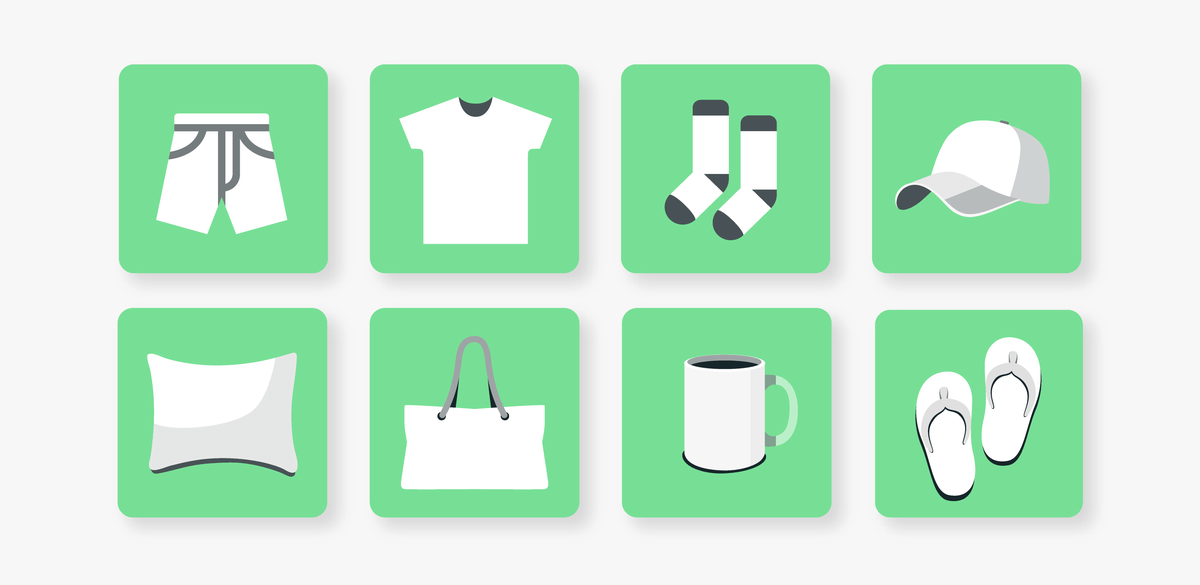
Both Printful and Printify offer an impressive selection of products that cater to various online store needs, including apparel, accessories, home goods, and more.
Printful provides over 330 white label products, including niche items and specialized product lines like embroidered clothing, wall art, and custom jewelry. This extensive catalog allows businesses to offer unique and diverse products, enhancing their brand appeal.
In comparison, Printify boasts a much larger catalog with over 900 products, giving online store owners a vast array of options to choose from.
However, despite its wide range, Printify may have limitations in certain specialized categories, where Printful’s focused and curated selection might offer more depth. This distinction is crucial for businesses looking to balance variety with quality and specialized offerings.
2. Pricing Structure
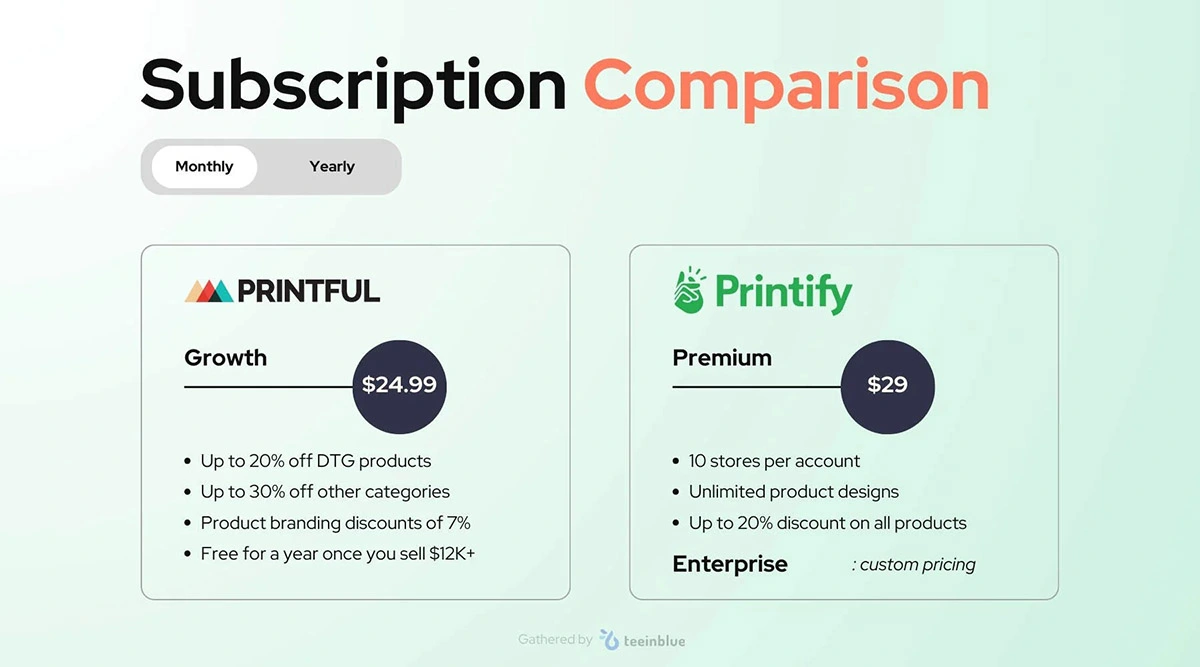
Understanding the cost structure of each platform is crucial for maximizing profitability in your print on demand business. Printful typically has slightly higher base costs due to its in-house production and comprehensive branding options, but these higher costs are often balanced by competitive per-item pricing and the absence of subscription fees.
Printify, by contrast, generally offers lower base costs because it outsources production to a network of third-party suppliers. However, this model can lead to variations in per-item fees, particularly for specific products or premium print providers.
Additionally, while Printify offers a tiered pricing structure, including a free plan and premium subscriptions, it's essential to consider potential extra costs, such as shipping costs and the varying quality of order fulfillment, depending on the chosen supplier.
Conducting a thorough analysis of pricing for your specific product range is essential to ensure you're selecting the most cost-effective platform for your online store. Here’s a quick overview of both platform’s pricing structure:
Printful Pricing Structure:
- Higher base costs due to in-house production and extensive branding options.
- Newly integrated membership structure that offers lower product prices and additional perks; Printful Growth ($24.99/month).
- Pay-as-you-go model, making it simpler for small-scale or new businesses.
- Potential for volume discounts and stable pricing for high-volume sellers.
- Comprehensive branding options like custom packaging, labels, and logos, with additional costs for these features.
- Free access to the Printful design maker, automatic order fulfillment, global order fulfillment, and customer support.
Printify Pricing Structure:
- Generally lower base costs by outsourcing production to third-party suppliers.
- Tiered pricing structure with three plans: Free, Premium ($29/month), and Enterprise (custom quote).
- Premium plan offers up to 20% discounts on all products, suitable for scaling businesses.
- Enterprise plan includes custom API integration, dedicated support, and advanced features for high-volume sellers.
- Potential variations in per-item fees depending on the selected print provider and product quality.
- Additional costs may include shipping and handling fees, which can vary by supplier and location.
3. Print Quality

When it comes to print quality, both Printful and Printify strive to deliver excellent results, but there are notable differences that may impact your choice.
Printful is widely recognized for its consistent print quality, offering vibrant colors, sharp details, and accurate print reproductions. This is largely due to their in-house production process, which allows for strict quality control at every stage of order fulfillment.
Printful also invests in advanced printing technologies, including Direct-to-Garment (DTG), embroidery, and sublimation, ensuring high-quality outcomes across a diverse range of products.
On the other hand, Printify, while also producing commendable prints, has faced some variability in quality due to its reliance on a network of third-party suppliers. This variability can occasionally result in minor discrepancies in color accuracy or print consistency, depending on the selected provider.
However, Printify's flexibility in choosing suppliers allows users to find a balance between cost and quality that best suits their needs.
4. Shipping Times

Printful’s extensive fulfillment network, consisting of facilities strategically located across the globe, enables it to offer consistently fast shipping times, particularly for international orders.
As a fulfillment company that handles production and shipping in-house, Printful’s streamlined process allows for efficient order fulfillment services and quicker delivery to various shipping locations. Typically, orders for apparel items are fulfilled within 2-7 business days, while non-apparel items can be shipped within 2-5 business days.
Printify’s shipping speeds, on the other hand, can vary more widely as the platform relies on a diverse network of third-party print providers. The variability in shipping location, provider efficiency, and distance from the fulfillment center can lead to longer or unpredictable shipping times.
While Printify offers flexibility in choosing print providers closer to the end customer, the reliance on external fulfillment services may result in inconsistencies in delivery speeds, making it essential for businesses to carefully select their providers based on their target markets.
5. Customization Options

Both Printful and Printify offer powerful customization tools that cater to a wide range of user needs, enabling you to imprint your unique designs on a vast array of products.
Printful stands out with its highly flexible design placement options, which allow for detailed customization of various parts of a product, such as sleeves, neck labels, and even the packaging itself.
This makes it a preferred choice for businesses looking to create fully branded merchandise with a professional finish. Printful’s design tools, including its mockup generator, are also robust, offering advanced features like 3D previews, which help users visualize their final products before proceeding with fulfillment.
While Prinitfy may not offer as many advanced customization options as Printful, the platform is designed to simplify the process of uploading and positioning designs, ensuring that users can quickly create and customize products.
Printify’s mockup generator is straightforward and supports multiple product types, making it easy for users to experiment with different designs and products without a steep learning curve.
Despite the differences in flexibility, both print on demand platforms provide comprehensive tools that support the creation of high-quality, customized merchandise, catering to various business needs and skill levels.
6. Customer Support

Reliable customer support is vital for any business, and both Printful and Printify offer varying levels of assistance to their users.
Printful is well-known for its proactive and responsive customer support. It offers multiple communication channels, including live chat, email, and phone support. New users benefit from a free onboarding session, which helps them get acquainted with the platform's features and tools.
Additionally, Printful provides a comprehensive blog and resource center filled with valuable insights on running a successful print-on-demand business, making it easier for users to navigate challenges and grow their ventures.
With Printify, the platform’s customer support experience can be less consistent.
While they offer a help center with articles covering key topics such as integrations, troubleshooting, and payments, the lack of 24/7 live support may be a drawback for some users.
Printify’s blog is rich with marketing tips, design trends, and success stories, but when it comes to immediate assistance, users may experience varying response times depending on the time of day and the complexity of their issues.
Overall, while both platforms are committed to supporting their users, Printful tends to provide a more dependable and accessible customer support experience.
7. Integration with Ecommerce Platforms
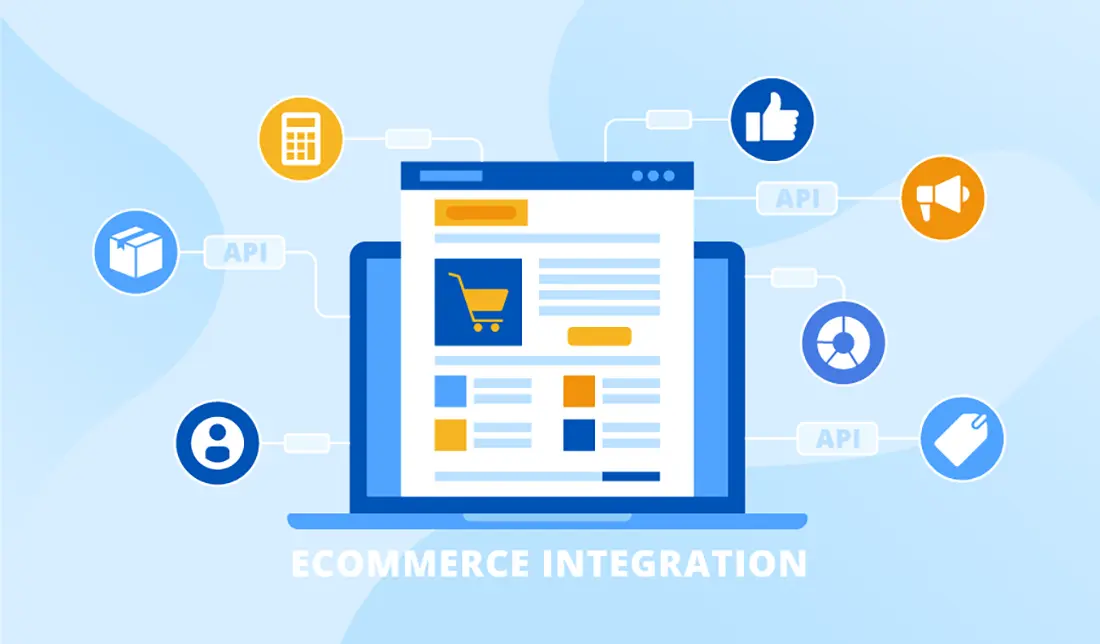
Both Printful and Printify offer seamless integration with various popular ecommerce platforms, making it easy for merchants to connect their online stores with print-on-demand services.
Printful stands out with its extensive list of integrations, which includes major platforms like Shopify, WooCommerce, BigCommerce, and Squarespace.
Additionally, Printful supports integrations with Weebly, Ecwid, PrestaShop, Big Cartel, Gumroad, Magento, 3dcart, Launch Cart, and Wix.
This broad compatibility ensures that businesses of all sizes and technical capabilities can easily automate their order fulfillment process and manage inventory without hassle.
Unfortunately, Printify takes a giant leap back in this department, as the platform only integrates with Etsy and eBay.
Despite having a more limited range of integrations compared to Printful, Printify’s focus on key platforms ensures that users can efficiently manage their stores and streamline operations.
For those looking to expand their reach further, Printful’s broader integration capabilities might be more appealing, especially for businesses looking to utilize more enterprise-oriented platforms.
8. Mobile Apps

When it comes to mobile apps, Printful has the advantage. The platform's app is available for both Android and iOS, while Printify is only available on Android.
Printful’s iOS app is particularly well-received, boasting a high rating of 4.7 out of 5 and thousands of positive reviews, highlighting its functionality and user-friendly design.
The app grants full access to Printful’s product designer, enabling users to create and manage their designs on the go.
In contrast, Printify currently only offers its mobile app for Android users, limiting accessibility for those on iOS devices.
While Printify's app facilitates essential tasks, it lacks the extensive features and strong user feedback seen in Printful’s iOS app, making Printful a more versatile choice for users seeking robust mobile support.
9. Additional Features
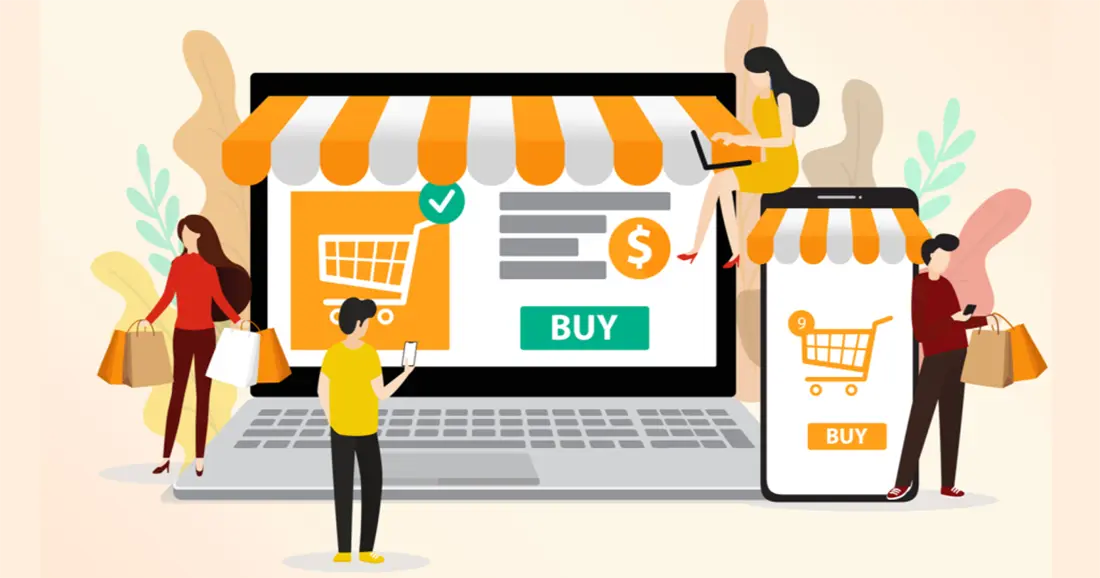
Printful sets itself apart from competitors by offering a comprehensive suite of additional services that extend beyond traditional print-on-demand capabilities.
In addition to its core printing services, Printful provides warehousing and fulfillment solutions, allowing businesses to store their products and manage inventory efficiently. This feature is particularly beneficial for sellers who want to streamline their operations and reduce shipping times.
Moreover, Printful offers professional product photography, enabling users to showcase their merchandise with high-quality images that can enhance their online presence and attract more customers.
On the other hand, Printify primarily concentrates on print-on-demand services, offering a solid platform for creating and selling custom products.
While it includes some ancillary features—such as an advanced mockup generator and integrations with popular ecommerce platforms—Printify lacks the extensive range of value-added services that Printful provides.
This focus means that while Printify is an excellent choice for those seeking straightforward print-on-demand solutions, Printful appeals to businesses looking for a more comprehensive approach to ecommerce and fulfillment.
Who Wins in 2024: Printful vs Printify
When it comes down to it, Printful is the clear choice for those seeking a comprehensive print on demand solution.
With its focus on product quality, Printful not only provides vibrant and accurate prints but also boasts an extensive range of integrations with popular online marketplaces and ecommerce platforms, making it easier for businesses to reach a wider audience.
Additionally, Printful offers a suite of advanced features, including user-friendly mobile apps, a robust product design tool, a logo generator, and diverse branding options, all designed to streamline the user experience and enhance brand identity.
While Printify has an impressive product range of over 900 items and offers discounts to its premium subscribers, its complexity can be a drawback for some users.
The need to navigate multiple vendors to compare pricing and shipping can complicate the order fulfillment process.
In the end, Printful offers a more streamlined and user-friendly experience for merchants looking to launch or scale their print on demand business.
Frequently Asked Questions
What is the difference between Printful vs Printify?
While both Printful and Printify are print on demand (POD) platforms, they differ significantly in their business models. Printful is a full-fledged fulfillment company that handles the entire production and shipping process in-house.
This offers greater control over quality and shipping times. Printify, on the other hand, acts as a marketplace connecting you with various print providers. This can lead to varying product quality and shipping speeds.
Which platform is better for beginners?
Printify's user-friendly interface and lower barrier to entry make it a more attractive option for beginners. However, the potential for inconsistent product quality might be a drawback. Printful offers a more comprehensive service but requires a steeper learning curve.
Can I use my own designs on both platforms?
Absolutely! Both Printful and Printify allow you to upload your own designs and customize a wide range of products, giving you the freedom to create unique merchandise that reflects your brand’s identity.
With user-friendly design tools, you can easily position your artwork on various items, from apparel and accessories to home decor, enabling you to bring your creative vision to life and effectively engage your audience.
Which platform offers better pricing?
Pricing can fluctuate based on product type, order volume, and shipping location. Generally, Printify tends to offer lower base costs, but per-item prices can vary depending on the print provider. Printful might have higher base costs but often provides competitive per-item pricing.
How long does shipping take?
Shipping times vary depending on the product, shipping destination, and the chosen production method. Printful often boasts faster shipping times due to its in-house fulfillment centers, but Printify's shipping times can be more variable depending on the print provider.
Can I dropship with Printful or Printify?
Yes, both platforms support dropshipping. This means you can sell products without holding inventory, as the POD company handles the entire fulfillment process.
Which platform offers a wider range of products?
Printful generally offers a more extensive product catalog, including niche items and specialized products. Printify also provides a solid selection but may have limitations in certain categories.
Which platform is better for custom products?
Both platforms offer customization options, but Printful often provides greater flexibility in terms of design placement and product modifications. Printify's customization tools are user-friendly but might be less extensive.
Can I integrate Printful or Printify with other e-commerce platforms?
Yes, both platforms integrate seamlessly with popular e-commerce platforms such as Shopify, WooCommerce, and BigCommerce. This allows you to manage your entire business from a single dashboard.
How do I choose between Printful and Printify?
The best platform for your business depends on your specific needs. Consider factors such as product range, pricing, shipping speed, customization options, and customer support.
If you prioritize product variety, fast shipping, and consistent quality, Printful might be the better choice. If you value a simpler setup and lower initial costs, Printify could be a good option.
By carefully evaluating your business requirements and conducting thorough research, you can select the POD platform that best aligns with your goals.
Looking For A Better Printful or Printify Alternative? Try Fourthwall!
Choosing the ideal POD platform hinges on a careful assessment of your business objectives and target audience. While Printful and Printify offer plenty of features and integrations, Fourthwall stands out as an exceptional alternative specifically designed for creators.
With a commitment to creator support and a comprehensive suite of features and tools, Fourthwall is a powerful choice for anyone looking to expand their brand while maintaining control over their creative output.
The platform offers creators the ability to build their own ecommerce shop with ease while offering hundreds of high-quality products to design and sell. Fourthwall is also free to join, with no annual or monthly subscription fees, allowing creators to focus on their craft without worrying about upfront costs
Whether you're launching a new line of products or simply want to offer unique designs to your audience, Fourthwall has you covered with the best print quality.
Sign up today and see your print on demand business flourish in no time!
















